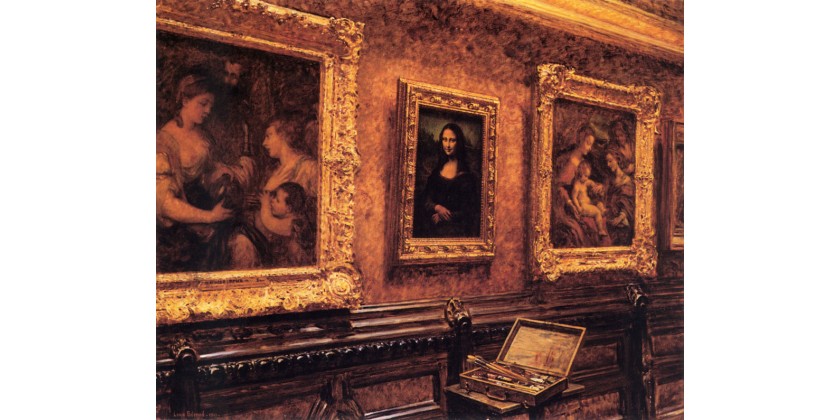History of framing moulding
Posted by artiklid 0 Comments 
History of framing moulding
Word “moulding” came to us from word “mould” or “mold” and it means shaped, coloured strip of wood, plastic, aluminium or other material, which is used for frame production and interior decoration. Traditionally moulding and picture frames, were produced from wood, but other frames were also found, produced from silver, bronze and other metals. During many centuries fashion and style of the picture frames has changed as well as art and interior direction. But 1 thing always remained the same. Well selected frame, will have a connection with the painting, will stress individuality of the painting and will put painting, not the frame on the first role.
Moulding was firstly used in Antic times. First frames, archaeologists found in the Egyptian tombs, more than 2000 years BCE. Archaeologists found fayum mummy portrait, framed into the wooden frame. This signifies, that this portrait before the burial was hanging in the house. However, frame of those times is more appropriate to call a border for the separation of interior and the portrait.
Moulding in interior design
Initially, moulding was used to hide clearance between decorations and the surface. Carved moulding was used for palace decoration, expensive houses and villas. Masters used moulding to decorate walls and sealings, for example to emphasise the mosaic and frescos. During moulding selection for the interior, masters tended to pick moulding, that it would harmonise with windows and doors.
During middle ages it was most frequently used to decorate temples, churches and somethimes it was used to decorate pieces of manuscritps.
Picture moulding
The oldest moulding was used as a border or a separator between paintings, pottery and building architecture. Egiptian and greek painters used mouding or the border, to separate its painting into small different sections. During those times pictures and paintings were made on painted panels and frame as well as painting was made from 1 piece of wood. Eve though, there are different production difficulties, frame and the border was cut for the purpose of defending the item and to add depth. After some time, more effective way developed. To produce moulding in meter wooden strips. Furthermore, these pieces of wood were cut and were attached to the wooden panel, creating the same effect as previously. Pieces of wood were attached to the panel with nails and glue. Example, of this can be seen in the picture.

Tabernacle frames
First independent self-supporting frame ( frame separated from the icom) was created by the painter Gentile de Fabiano in 1423, and in that frame was inserted painted panel from the altar „Adoration of the Magi“. This frame is associated with Gothic style and is associated with Venetian direction. Later example of this tabernacle frame is Fra Angelico’s Annunciation . These paintings and frames inspired craftsmen for creation of frames for private collections.

Cassetaframes
Frame design on the altars developed together with architecture. During 15-16 centuries portrait art direction, which was going outside of the religious motives and it also developed frames. In order to frame portraits, casseta frames were used (“small box”).
Casseta frame included widened identical profile from all 4 sides of the frame. Structure of these frame, was used from simplified tabernacle frames, which made them more accessible. During 16-17 centuries profile and moulding of these frames developed regional tendencies and motives, which led to the rise of regional styles (Toscan, Venetian, Bolognian, Neopolitan). These frames were joined horizontally with 90 degrees.

Gallery frame
As it was written previously, main difference between casseta and tabernacle frames, is that casseta frame has identical profile from all 4 sides of the frame. However, there is 1 type of the frames – gallery frame (the most appropriate name), which clears the gap between these 2 types of the frames. As casseta frame, gallery frame is decorating the painting. Gallery frames could be symmetrical (same as casseta frames), but lack of structural parts clasify it tabernacle frame. In addition, gallery frames could be symmetrical horizontally and vertically, to have casseta frame construction, but there will be differences in profile across the frame.
Most famost gallery frames can be Sansovino frames (carved frames). Their name came from Florence sculptor and architect Jakopo Sansovino, who lived in Florence from 1527 until his death in 1570 years. Main feature of his frames, were overlapping and intertwining scrols and volutes, somethimes enlivened with birds, animals and humans. This frames were used during rennesance, when paintings of great masters needed beautiful and worthy framing. Craftsmen developed frame production techniques. Framing was becoming an art on its own. Moulding was starting to become rich and refined. During those times, painters also created drawings of the frames and tried to implement it in the reality. This type of the frames existed until 17th century and became a symbol of Venetian frame style. After, based on types of these frame, more simpler versions were implemented in the more modern times.
Frame materials during Renaissance
Renaissance craftsmen very laboriously treated different types of wood during creation of ornament frames. Not expensive types of wood (poplar, spruce and pine) were left for the secondary parts of the frames. Because of its even profile structure poplar was used for carving simpler parts of the moulding. Linden, which is similar to poplar, was used for more difficult carved frames. All these types of the wood, were used to create frames, which were afterwards guilded and fully covered. Walnut, which is a more rare and expensive wood, was used for frames, which were unguilt or parcel-guilt (luminolegno). Rich colours of walnut made this wood more expensive and made it valued by the craftsmen. Frequently, craftsmen tried to imitate walnut with other wood types. In the middle of 16 century, ebony was usedfor the profiles of expensive moulding, which was decorated with semiprecious stones. Oak was rarely seen with Italian frames.
Conceptual frames
During renaissance paintings and icons received not only “material frames” but also conceptual frames. That is why, frames reminiscent of “window on the wall”, first have seen the day light. Later, during Kant times, this will be added into academic art theory and will be strengthened with system of thoughts about paintings, associated with craft and antique. This ment, that work of the artist was “framed” not only with material frame, but also framed with contextual meanins, written and oral declarations, taken from exhibitions, books and author notes. With some simplication it can be said, that frame for visual image – is a meeting between author of the painting and viewer sight and as a result artistic image is born. In addition, painting is an item with a historically changing importance, as it is perceived differently during centuries.
Useful links:











